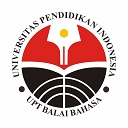POLITENESS OF WOMEN’S LANGUAGE (JOSEIGO) BY SHIN TANOKURA IN DRAMA SERIES OF OSHIN
Abstract
This study aims to assess information about variety of women’s language by Shin Tanokura, women’s language that represent the principles of politeness and politeness scale in drama series of Oshin. Research based on theory of Kindaichi (1988) for variety of women’s language and theory of Leech (2011) for the principles of politeness and politeness scale. This is kind of qualitative research. The method used in this research is the descriptive analysis. Source of data in this study is drama series of Oshin. While the data in this study are uttarances containing women’s language, women’s language that represent the principles of politeness and politeness scale. Data collection technique which used is observing method.The results showed, variety of women’s language by Shin Tanokura in drama series of Oshin is based on the theory of Kindaichi (1988): 1) Goi level, consists of using shuujoshi (wa, kashira, mono dan no), kantanshi (maa dan ara), ninshoudaimeishi (atakushi, atashi dan anata), koshou (~san, ~sama dan anata), keigo (teineigo, kenjougo dan sonkeigo) dan wago (tsuite iku); 2) Tougo level, consists of using iikirenai hyougen dan kurikaeshi hyougen; 3) Danwa level, consists of using youkyuu hyougen, aizuchi dan aisatsu, kimari monku. The classifications above represented in six maxims of the principles of politeness, tact maxim, generosity maxim, approbation maxim, modesty maxim, agreement maxim and sympathy maxim. According on theory of Leech (2011), there are three politeness scales, 1) Profit and loss scale, 2) Indirect scale and 3) Which like scale. Then, three scale are linked to one another and implemented in women’s language by Shin Tanokura in drama series of Oshin, the result are profit on addressees-direct-high, profit on addressees-direct-medium, profit on addressees-direct-low, profit on addressees-indirect-medium, profit on addressees-indirect-low, profit on speaker, addressees-direct-low and profit on speaker, addressees-indirect-high.
Keywords
Full Text:
FULLTEXT PDFReferences
Azuma, Shoji. 2009. Shakai Gengogaku Nyuumon (Ikita Kotoba no Omoshirosa ni Tsuiru). Tokyo: Kenkyuusha Insatsu Kabushikigaisha.
Chaer, Abdul dan Leonie Agustina. 2010. Sosiolinguistik Perkenalan Awal. Jakarta: Rineka Cipta.
Chino, Naoko. 2004. Diterjemahkan oleh Nasir Ramli: Partikel Penting Bahasa Jepang. Jakarta: Kesaint Blanc.
Hirai, Masao. 1989. Nandemo Wakaru Shinkokugo Handobukku. Tokyo: Sanseido.
Koizumi, Tamotsu. 2013. Nyuumon: Goyouron Kenkyuu (Riron to Ouyou). Tokyo: Kenkyuusha.
Kindaichi, Haruhiko dkk. 1988. An Encyclopaedia of The Japanese Language. Tokyo: Taishukan Publishing Company.
Leech, Geoffrey. 2011. Prinsip-prinsip Pragmatik. Jakarta: Penerbit Universitas Indonesia.
Mahsun. 2005. Metode Penelitian bahasa (Tahapan Strategi, Metode, dan Tekniknya). Jakarta: Raja Grafindo Persada.
Masamune, Mineko. 1998. “Nihongo ni Okeru Joseigo-Danseigo (On Women’s Speech and Men’s Speech in Japanese Language)”. Kitariku Daigaku Kiyou, 22, 157 – 163.
Miles, Matthew B. & A. Michael Huberman. 2009. Analisis Data Kualitatif. Jakarta: Penerbit Universitas Indonesia.
Mizuntani, Osamu dan Nobuko Mizutani. 1987. How to be polite in Japanese. Tokyo: Japan Times.
Nakamura, Junko. 2000. “Shuujoshi ni Okeru Danseigo to Joseigo”. Shinshuu Daigaku Ryuugakusei Sentaa Kiyou, 1, 1 – 11.
Nomura, Masaaki & Seiji Koike. 1978. Nihongo Jiten. Tokyo: Tokyodou.
Reiichi, Hori. 1990. Onna no Kotoba. Tokyo: Meiji Shoin.
Setyorini, Wiwik. 2007. Tinjauan Penggunaan Shuujoshi (終助詞) sebagai Ragam Bahasa Jender dalam Kelas Bahasa Jepang di Perguruan Tinggi Jawa Timur. Tesis tidak diterbitkan. Surabaya: Pascasarjana Unesa.
Shinmura, Izuru. 1983. Koujien (Daisanban). Tokyo: Iwanamishoten.
Subandi. 2008. Laporan Penelitian Fundamental Lanjutan: Persepsi Masyarakat Jepang Terhadap Ragam Bahasa Wanita Masyarakat Jepang. Surabaya: Lembaga Penelitian Unesa.
Sudaryanto. 1993. Metode dan Teknik Analisis Bahasa: Pengantar Penelitian Wahana Kebudayaan secara Linguistis. Yogyakarta: Duta Wacana University Press.
Sudjianto. 1996. Gramatika Bahasa Jepang Modern Seri A. Jakarta: Kesaint Blanc.
Sudjianto. 2007. Bahasa Jepang dalam Konteks Sosial dan Kebudayaan. Jakarta: UPI Press.
Sudjianto dan Dahidi, Ahmad. 2004. Pengantar Linguistik Bahasa Jepang. Jakarta: Kesaint Blanc.
Sudjianto dan Dahidi, Ahmad. 2009. Pengantar Linguistik Bahasa Jepang. Jakarta: Kesaint Blanc.
Sugiyono. 2012. Metodologi Penelitian Kuantitatife, Kualitatife, dan R&D. Bandung: Alfabeta.
Sutopo, HB. 2006. Metode Penelitian Kualitatif. Surakarta: UNS Press.
Tamamura, Fumio. 2001. Nihongogaku o manabu hito no tame ni. Tokyo: Sekaishishousha.
Wijana, I Dewa Putu. 1996. Dasar-dasar Pragmatik. Yogyakarta: Andi Offset.
Wijana, I Dewa Putu dan Rohmadi, Ahmad. 2006. Sosiolinguistik (Kajian Teori dan Analisis). Yogyakarta: Pustaka Pelajar.
DOI: https://doi.org/10.17509/japanedu.v3i1.11279
Refbacks
- There are currently no refbacks.
Copyright (c) 2018 JAPANEDU: Jurnal Pendidikan dan Pengajaran Bahasa Jepang

This work is licensed under a Creative Commons Attribution-ShareAlike 4.0 International License.
 Published by:
Published by: Department of Japanese Language Education, Faculty of Language and Literature Education
Universitas Pendidikan Indonesia
 Online ISSN: Online ISSN:2528-5548 |

JAPANEDU: Jurnal Pendidikan dan Pengajaran Bahasa Jepang (e-ISSN:2528-5548) lisenced under a Creative Commons Attribution-ShareAlike 4.0 Internasional (CC BY-SA 4.0)

